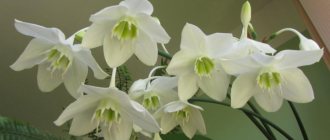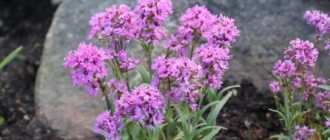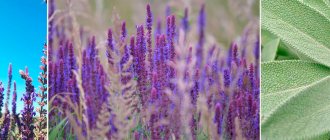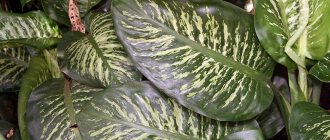Lantana flower: photo, home care, popular types
Lantana is a small bush or tree belonging to the verbena family.
The first information about its existence dates back to the distant 18th century. It is believed that it was then that lantana was discovered by the Spaniards.
The content of the article:
1. General information about lantana 2. How to properly care for lantana 3. How to properly replant lantana 4. Lantana fertilizers 5. Dangerous diseases and pests 6. Pinching and pruning 7. Reproduction methods 7.1 Propagation by seeds 7.2 Propagation by cuttings 8. Medicinal properties 9. The most popular types of lantana 9.1 Lantana Montevideo 9.2 Lantana camara 9.3 Lantana Lyubava 9.4 Lantana variegata
Lantana: care and cultivation features
The nuances of keeping the plant depend on the method used: in an apartment, in a country house or in a tub culture.
Ground and location
For an apartment flower, the soil should consist of equal parts of turf soil, sand and humus. The plant loves active watering during the period of active growth. But it is important to avoid excess moisture, as it is no less destructive than drought.
It is best to place it on windows facing southeast and southwest. In summer, the light should be diffused. But the sun is a prerequisite for flowering.
Humidity and temperature
High humidity combined with high air temperature is detrimental to the flower. To achieve good branching, a lush crown, and the tips of the shoots should be pinched regularly. Lantana survives pruning well. Therefore, tall shoots must be shortened in time.
Once every 15 days it is necessary to provide complementary feeding with nutritious mineral preparations.
How to care:
- If the pot becomes small, then you should transplant it using the transfer method into a larger container. The month of July is best suited for these purposes. Replanting will ensure better flowering.
- In winter there comes a time of rest, which is important to organize correctly. Lantana should be placed in a bright room with a temperature of 12-14 degrees.
- Watering becomes less frequent. But it is strictly forbidden to overdry the soil. If the foliage has completely fallen, then the temperature should be maintained at about 6-8 degrees Celsius.
- In the spring, weak shoots are pruned and pinched to form a lantanta shape. Propagation by cuttings can be done just from the resulting branches.
Pests
When a whitefly pest appears on a flower, you need to wipe all the leaves on both sides with a damp cloth every day for 14 days. If there are a lot of insects, then the plant is sprayed with a preparation against cockroaches and placed in a bag that is tied.
The flower moves for a day to an open balcony or loggia in partial shade. Then, it is rinsed under a fresh shower.
Spraying
It is also advisable to periodically spray with water from a spray bottle. Although lantana tolerates dry conditions well, lack of moisture can cause spider mites or scale insects.
Water should be used soft, at room temperature. It is advisable that it does not fall on the inflorescences to prevent the formation of fungi.
Previously, we told you how to care for blechnum fern.
Contents using the tub method
Care is carried out similarly to indoor culture. The only difference is that the container with lantana gradually begins to be hardened and taken outside in the spring. But these actions should be carried out only when there is no longer any risk of frost.
Before the autumn cold snap, the flower is cut short and placed in a cool greenhouse with a temperature of about 7-9 degrees Celsius. Watering is rare.
Diseases
If the lantana in the tub is attacked by a whitefly, the plant is treated with Fitoverm according to the instructions. Particular attention should be paid to the inside of the leaves. Be sure to perform the procedure away from other plants, for example, in the backyard.
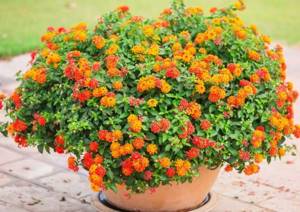
General Information about Lantana
Currently, the evergreen lantana plant can grow both at home (in this case its growth reaches only 50 cm) and in the natural environment.
Anyone can admire the unusual flowers, striking with their bright colors, by visiting Argentina, Peru, Ecuador, or by choosing to travel to the Krasnodar Territory, namely the city of Sochi.
Photo of lantana flower
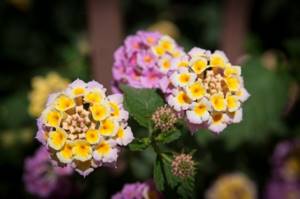
The Thais will present lantana trees to tourists. Their main feature is the fact that several plant varieties can be grafted onto one such tree trunk at the same time.
The stem of the plant is covered with small spines. Lantana leaves are tooth-shaped and deep green.
The flowers are small, collected in cups - inflorescences. Their color scheme may vary depending on what stage of flowering the shrub is in. A distinctive feature of this plant, which attracts the interest of gardeners, is the ability to combine several shades of flowers or even different flower petals at the same time on one branch.
This is interesting!
So,
lantana can be purple, yellow, pink, red or orange
. For this, the Czechs nicknamed her “the girl’s word,” hinting at his inconstancy.
Without requiring particularly meticulous care, lantana can bloom from late spring to late summer,
despite the fact that the life of one blossoming flower is only three days. But there is controversy regarding the aroma that this tree smells of.
Some people like it and hear notes of lemon balm and even camphor in it, while others associate lantana with the unpleasant smell of cat litter.
Planting lantana in open ground - video
Species cultivation
Lantana camara flower
It is an evergreen shrub plant. The length and width of this specimen range from 1 to 2 meters. At home, such lantana creates small compact variations up to half a meter in height.
Stems are straight and branched, tetrahedral. Sometimes they have spines on their body. The leaves have an oval oblong shape. The surface is embossed and wrinkled. The length does not exceed 10 centimeters. They have the aroma of warm grass.
The flowers are small. They are collected in inflorescences about 5 cm in size. The process occurs from late spring to mid-autumn.
Interesting blue-black fruits and berries with a bluish bloom ripen.
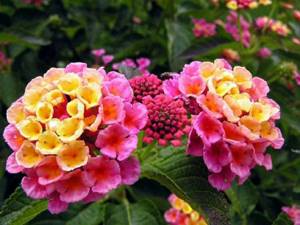
French breeders have done a good job of developing beautiful varieties. They were able to move away from the original multi-colored varieties and create monochromatic varieties. The palette has become brighter and more varied.
Samantha and White Drift
Thus, lovers of monotonous flowering actively use the varieties “Samantha” and “White Dwarf” in their cultivation. The first has a bright yellow color, the second is white.
Aloha
In container growing, the “Aloha” variety has become one of the most popular. It has descending soft shoots. The leaves are bright and the flowers are pale yellow.
Goldsonne
The “Goldsonne” variety has proven itself in the field of hanging cultivation. It has bright yellow flowers and spreading shoots.
Sterile varieties of the plant have also been developed. They bloom beautifully and abundantly, but fruit set does not occur. These include the following: “New Gold” (it has bright yellow flowers), “Miss Huff” (coral, yellow and orange inflorescences), “Silver Mound” (cream with a yellowish center). These species perfectly decorate the garden plot in the summer.
Varieties of dwarf sizes are in particular demand.
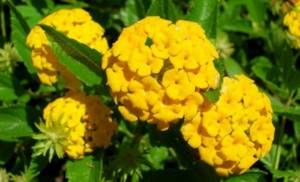
How to properly care for lantana
Being an unpretentious plant, lantana does not require much attention from its owner, but it is worth listening to some of its needs in order to end up with a healthy, abundantly and long-flowering tree.

Lighting
Thanks to the efforts of breeders, hybrid varieties of lantana grow much slower than their founder and have a low stem, which allows them to be grown in an ordinary city apartment.
For them, it would be most advisable to find sun-drenched window sills on the south side of the apartment. The plant not only calmly tolerates direct rays of the sun, but is also able to survive extremely high air temperatures.

Bright light allows the leaves to grow green mass and ensures the presence of a large number of flowers in the future. In a dark place, lantana, on the contrary, becomes smaller, and the frequency of its flowering sharply declines.
Air temperature
Lantana, which grows in hot countries, loves warmth. If the plant is planted in a pot, then the temperature in the room should not fall below 12 degrees Celsius. In open ground, the shrub can easily survive the winter, provided there is no frost. The ideal air temperature for the plant is considered to be around 15-25 degrees.
Caring for lantana at home - video
Air humidity
Lantana feels comfortable at home. However, insufficient air humidity can negatively affect her health. So, in an excessively dry climate, the owner of the plant will have a difficult fight against spider mites.
Photo of lantana spraying

In order to avoid such troubles, it is enough to only spray the tree twice a day, thereby maintaining the optimal ratio of air humidity and temperature.
During the flowering period, you need to do this carefully, trying not to get water on the flowers themselves.
Watering lantana
Lantana requires constant, abundant watering.
The owner of the plant must conscientiously ensure that the soil in the pot does not dry out, and this nuance applies not only to the summer, but also to the winter. With a lack of watering, lantana fades, and the buds already present on the plant fall off without ever blooming. The water should first be settled to bring it to room temperature and passed through a filter.
Photo of watering a flower

Soil for lantana
The ideal soil for lantana is a mixture that includes
:
- 3 parts leaf soil;
- 3 parts of turf;
- 1 part of coarse sand;
- 1 part humus.
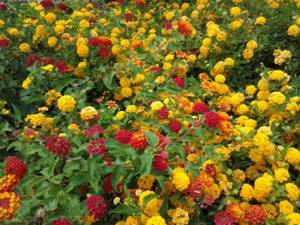
This combination will make the soil loose and allow water to pass through it well.
You can prepare such soil on your own, or purchase a ready-made substrate at a flower shop.
Flower placement
This southern plant loves well-lit places. The better the lighting of the place where the pot with the shrub is located, the more abundantly it will bloom. The ideal location for the pot is window sills on the southwest or southeast side of the room. In order for a shrub to bloom actively, it requires at least 5-6 hours of good lighting.
But it should be taken into account that lantana does not like drafts and cold winds. Therefore, when ventilating rooms, it is better to put the plant in a place protected from them.
In the summer, when the weather is already warm, this indoor plant can be safely planted in the garden in open ground, decorating your landscape. At the end of the summer season, the shrub can also easily be returned to its place or transplanted into a new pot, slightly larger than the previous container. If you don’t want to replant the plant, then just put the pot with it on the veranda or lawn.
Growing lobularia marine at home
Also, this perennial tolerates pruning remarkably well and provides its owner with the opportunity not only to give himself a fancy shape, but also the opportunity to grow a bush of the height he desires. Typically, a garden shrub can grow up to one and a half meters; indoor species reach an average of 30-40 centimeters in height.
How to transplant lantana correctly
According to the rules, lantana must be replanted every 2-3 years.
This necessity is explained by the fact that the roots of the plant have the habit of growing quickly and the flower becomes cramped in an old pot.
It is best to choose spring for transplantation,
when the plant begins to emerge from winter hibernation.
Photo of flower transplantation
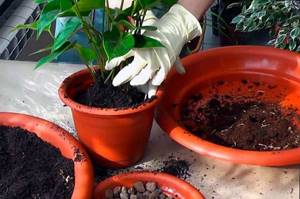
The pot is chosen deep, several centimeters wider in diameter than its predecessor. Drainage in the form of pebbles or expanded clay must be laid at its bottom. Drainage ensures that water does not stagnate in the pot.
The old soil is removed so that the plant has the opportunity to get enough of the new soil
all nutrients in the amount it needs.
Features of transplantation
Since the roots grow quickly, lantana is replanted every 1-3 years. It is better to do this in the first half of spring. The pot should be spacious and deep. Place drainage material (shards, expanded clay, pebbles) on the bottom so that water from irrigation does not stagnate.
The following components must be included in the soil for lantana:
- leaf soil (4 parts);
- turf land (3 parts);
- humus soil (1 part);
- river sand (1 part).
During transplantation, part of the old earthen coma is removed so that the plant receives more nutrients from the new soil.

Lantana fertilizers
At the moment of flowering and before the completion of this process, the flower requires feeding in the form of fertilizers. They must be added to the ground 2 times a month in an already diluted form.
FERTILIZERS FOR THE GARDEN AND VEGETABLE VEGETABLE!
Epin extra: using fertilizer for indoor plants Superphosphate Potassium monophosphate Nitrogen fertilizer
In this case, organic and mineral fertilizers should be alternated with each other.
Any fertilizers designed specifically for flowering indoor plants are perfect for these purposes.
You shouldn't overdo it in this matter either. Excessive fertilizer will stunt the growth of lantana.
Dangerous diseases and pests of lantana
Among the diseases to which this evergreen plant is susceptible, the most common is mold.
It appears in the soil around the plant.
In order to protect the shrub, the gardener should keep it in a warm room with a normal level of air humidity. If the plant is already infected, it should be treated with a fungicide and pruned.
Photo of mold on a flower
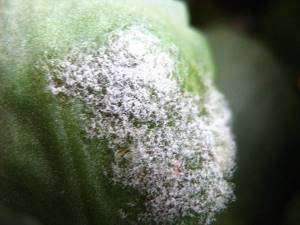
Leaf rust is no less dangerous for lantana.
By its nature, this disease is fungal and it is quite difficult to fight it.
Leaf by leaf changes its color from a beautiful, pleasing green shade to a fading brown. To combat rust, various types of spraying are used using specially prepared compounds.
Photo of leaf rust on a flower

Pests do not ignore lantana either. Thus, mealybugs, scale insects, whiteflies and spider mites are not averse to feasting on its succulent foliage. To prevent pests, many gardeners use Aktara and Aktellik.
Pinching and pruning lantana: how to get a beautiful and lush plant
In the spring, when the plant moves from the dormant stage to the active growth stage, it is necessary to carry out the procedure of pruning its shoots and pinching them, as well as removing already faded inflorescences.
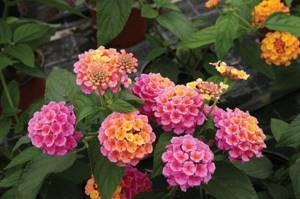
These procedures will help create the most beautiful crown of the plant, thick and luxuriantly blooming. Usually, with proper pinching, lantana flowers have so many flowers that the leaves become completely invisible behind them.
In addition, with the help of these simple manipulations, you can get a tree of the shape that is closest to the owner of the lantana:
- standard tree;
- ball;
- ampelous flower.
Useful article:
How to improve the soil, its fertility, composition, structure
Lantana propagation methods
At the moment, the following methods of propagating the “maiden word” are known:
:
- seeds;
- cuttings.
How to propagate lantana from seeds
When choosing seeds as a method of propagating lantana shrubs, you should plant them in specially prepared soil towards the end of winter.
It is important that the soil is loose and contains all the necessary nutritional properties.
Photo of lantana propagation by seeds
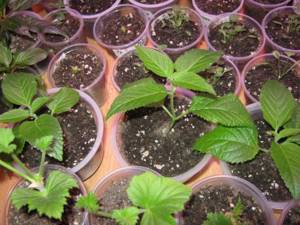
The room temperature should be at least 20 degrees Celsius.
The first shoots will not take long to appear and within 2 weeks they will appear on the soil surface. After the seedlings reach 10 cm, it is best to plant them in separate containers.
How to propagate lantana from cuttings
To propagate lantana using cuttings, select only the freshest shoots on which rough bark has not yet formed.
Root lantana in water or nutritiously moist soil. When the plant is sufficiently rooted, it will definitely open its first flower, because young plants develop faster than perennial ones.
Photos of lantana cuttings
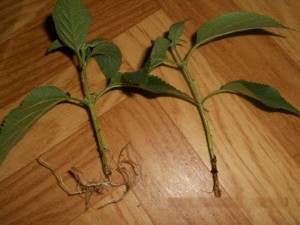
Lantana propagation by cuttings - video
Medicinal properties of lantana
Traditionally, lantana of the verbena family belongs to plants with excellent medicinal properties. Previously, it was actively used in the treatment of such serious illnesses as malaria, paralysis or even a snake bite.
The Spaniards use lantana to combat skin damage: cuts, bruises, wounds and dermatitis.
For stomach pain, cold viruses and rheumatism, a decoction of lantana leaves was taken. Dry leaves served as a repellent.
It is important to remember that lantana fruits when unripe are toxic and pose a threat to the health of both people and their pets.
BEAUTIFUL FLOWERS!
Nerine flower or Spider Lily Weigela Hydrangea
The most popular types of lantana
Currently, breeders have developed a huge variety of varieties and species of lantana. The most popular of them will be described below.
Lantana Montevidea
This variety of lantana will fit perfectly into the interior of any apartment or country house. It seems to be specially designed to grow in beautiful boxes on the balcony, or flowerpots hanging from a height.

The shoots of the plant are creeping, ampel-shaped and incredibly flexible. The leaves are small, the petiole is less long than in other types of lantana. The flowers of Lantana Montevideo are usually purple or pinkish-lilac. But science has also managed to develop the Montevideo lantana shrub with yellow flowers.

Lantana camara
Perhaps the most common and popular variety of lantana.
Its inflorescences attract people's gaze. Depending on the maturity of the flower, it can be pink, dark red, orange or yellow.

The shoots of the bush are drooping. Lantana camara looks great in hanging flower pots and garden beds. The leaves retained their variegated color.
Lantana Lyubava
Externally, it is a 1.5 meter shrub with small red-orange flowers. Lantana Lyubava begins to bloom in early spring and ends in late autumn.

Lantana variegata
It is distinguished by its variegated leaves with whitish inclusions. Bred artificially, the variety of lantana variegata needs special care and additional protection.
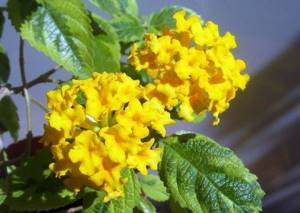
Types of flower
The most popular varieties of this plant are Lantana camara (also known as Lantana vaulted) and Lantana Montevideo.
Lantana vaulted is a plant with an erect stem that is herbaceous when young, but becomes woody over time. The stem is covered with small spines and can grow up to one and a half meters. The leaves of the plant are jagged and green. The flowers are small and can be of different colors: yellow, purple, pink and bright red. They are collected in small variegated inflorescences that can reach five centimeters in diameter. Lantana camara bears poisonous berries.
Lantana Montevideo has flexible shoots that spread along the ground, and its leaves are much smaller than those of the camara. Its inflorescences are also smaller: their diameter does not exceed three centimeters. Unlike camara, lantana Montevideo is more often grown in pots and hanging baskets. The flowers are dominated by lilac, purple, pink and their shades, but relatively recently new varieties have been developed that have yellow and white flowers.


